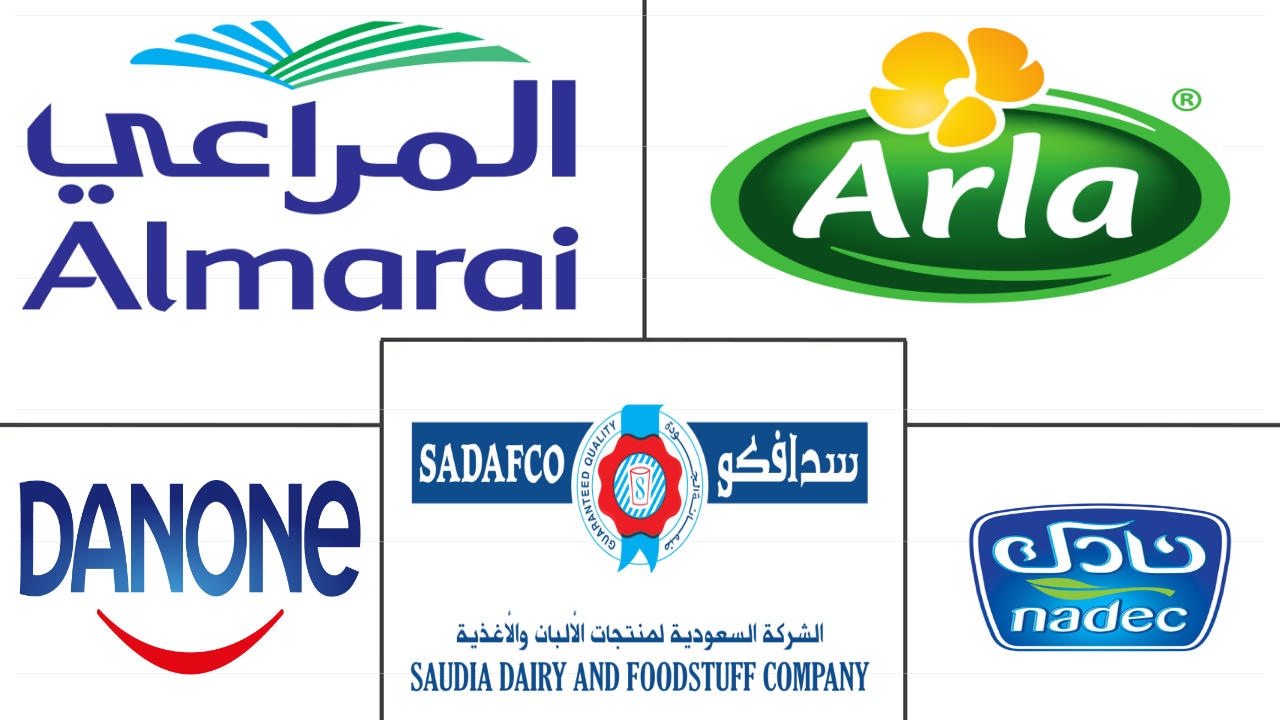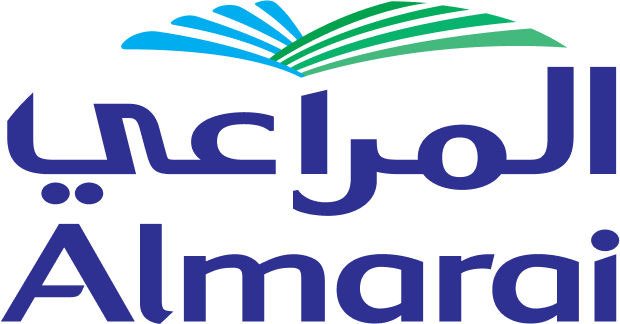Market Size of middle east dairy Industry
| Icons | Lable | Value |
|---|---|---|
|
|
Study Period | 2017 - 2029 |
|
|
Market Size (2024) | USD 18.89 Billion |
|
|
Market Size (2029) | USD 23.43 Billion |
|
|
Largest Share by Distribution Channel | Off-Trade |
|
|
CAGR (2024 - 2029) | 4.40 % |
|
|
Largest Share by Country | Saudi Arabia |
|
|
Market Concentration | Low |
Major Players |
||

|
||
|
*Disclaimer: Major Players sorted in no particular order |
Middle East Dairy Market Analysis
The Middle East Dairy Market size is estimated at 18.89 billion USD in 2024, and is expected to reach 23.43 billion USD by 2029, growing at a CAGR of 4.40% during the forecast period (2024-2029).
18.89 Billion
Market Size in 2024 (USD)
23.43 Billion
Market Size in 2029 (USD)
2.83 %
CAGR (2017-2023)
4.40 %
CAGR (2024-2029)
Largest Market by Category
30.80 %
value share, Milk, 2023

Growth in the milk segment is driven by its increasing demand across various applications/cuisines in the region with increased production as well, during the study period.
Largest Market by Country
31.04 %
value share, Saudi Arabia, 2023
The regulations related to halal beverages and the increasing popularity of packaged dairy products in Saudi Arabia have emerged to be some of the factors driving the country in the region.
Fastest-growing Market by Category
6.24 %
Projected CAGR, Sour Milk Drinks, 2024-2029
Improved dietary choices due to rising health concerns among consumers is one of the major factors driving the preference towards sour milk drinks in the region.
Fastest-growing Market by Country
5.35 %
Projected CAGR, Qatar, 2024-2029
The government's regulations are largely supporting Qatar in the region. It aimed to maintain a continuous supply of essential food commodities to the local market.
Leading Market Player
11.42 %
market share, Almarai Company, 2022

The increased manufacturing capacities with efforts towards the safety and quality of the products is making Almarai Co., Ltd. to be the market leader in the year studied.
Widespread adoption of distribution channels, led by remarkable sales through supermarkets and hypermarkets is propelling the growth
- In 2022, the distribution channel in the Middle East witnessed a growth of 2.69% compared to 2021. Off-trade retailing dominated Middle East's retail space during the review period (2017-2022). In 2022, off-trade retailing held a share of 81.26%. In the Middle East, consumers are highly fascinated by off-trade retailing due to the greater convenience they get when purchasing dairy products.
- On-trade retailing held a share of 18.73% in the Middle East in 2022. In on-trade channels (quick-service restaurants), the prices are fixed for dairy products, while consumers are given several options in off-trade channels. In the Middle East, off-trade channels offer dairy products at varied prices (low, medium, and high). The milk sold by these retailing units is available from USD 2.78 to as high as USD 35.4. The availability of milk at varied prices also promotes the buying power among consumers as they can purchase the products that suit their affordability parameters.
- In the Middle East, off-trade retailers focus on providing various dairy products, including different flavors such as unsweetened, chocolate, and vanilla. To increase the consumer base, they offer consumers complete information about the products, such as product specifics (ingredient used, seed used, and others). As a result, consumers are engaged in purchasing their milk beverages through off-trade modes.
- During the forecast period, the demand for dairy products is expected to increase due to the rising health consciousness among the population. As a result, the dependency on retailing units is expected to grow during 2025-2026, as they offer consumers higher visibility about the product.
Saudi Arabia plays a major role in the consumption of dairy products in the region
- Saudi Arabia and Iran are identified as the major markets in the region. These two countries collectively accounted for a 52.2% share in the overall dairy products volume sales across the region in 2022. The key driving factors are the high production of raw milk, rising consumer preference for quality dairy products, and adequate industry regulation to facilitate the manufacturing and trading of dairy products.
- Saudi Arabia is the largest dairy producer in the GCC countries, supported by the highest consumption of dairy products in the country. In 2022, the consumption of dairy products in Saudi Arabia reached around USD 5,479 million, representing a 2.9% growth compared to the previous year, 2021.
- Iran’s dairy industry has a nominal production capacity of 12 million metric tons per annum. Around 650 licensed dairy production units are active across the country. Also, dairy exports rose by 14% in 2021, from 1.22 million tonnes to 1.39 million tonnes in 2022.
- The United Arab Emirates is identified as the fastest-growing dairy market in the Middle East. The UAE market is anticipated to grow by 13.4% in 2025 from 2022. Milk is the leading category in the UAE market, accounting for 26.8% of the market value in 2022. Consumers in the country spend a major portion of their income on milk as they consider it a pro-health beverage.
- In the Middle East, the Israeli dairy industry is considered one of the most advanced. As of 2021, approximately 125,000 cattle made up the Israeli dairy herd. In the Israeli dairy industry, a cow produced 12,000 kg of milk annually on average in 2021.
Middle East Dairy Industry Segmentation
Butter, Cheese, Cream, Dairy Desserts, Milk, Sour Milk Drinks, Yogurt are covered as segments by Category. Off-Trade, On-Trade are covered as segments by Distribution Channel. Bahrain, Iran, Kuwait, Oman, Qatar, Saudi Arabia, United Arab Emirates are covered as segments by Country.
- In 2022, the distribution channel in the Middle East witnessed a growth of 2.69% compared to 2021. Off-trade retailing dominated Middle East's retail space during the review period (2017-2022). In 2022, off-trade retailing held a share of 81.26%. In the Middle East, consumers are highly fascinated by off-trade retailing due to the greater convenience they get when purchasing dairy products.
- On-trade retailing held a share of 18.73% in the Middle East in 2022. In on-trade channels (quick-service restaurants), the prices are fixed for dairy products, while consumers are given several options in off-trade channels. In the Middle East, off-trade channels offer dairy products at varied prices (low, medium, and high). The milk sold by these retailing units is available from USD 2.78 to as high as USD 35.4. The availability of milk at varied prices also promotes the buying power among consumers as they can purchase the products that suit their affordability parameters.
- In the Middle East, off-trade retailers focus on providing various dairy products, including different flavors such as unsweetened, chocolate, and vanilla. To increase the consumer base, they offer consumers complete information about the products, such as product specifics (ingredient used, seed used, and others). As a result, consumers are engaged in purchasing their milk beverages through off-trade modes.
- During the forecast period, the demand for dairy products is expected to increase due to the rising health consciousness among the population. As a result, the dependency on retailing units is expected to grow during 2025-2026, as they offer consumers higher visibility about the product.
| Category | |||||||||
| |||||||||
| |||||||||
| |||||||||
| |||||||||
| |||||||||
| Sour Milk Drinks | |||||||||
|
| Distribution Channel | |||||||
| |||||||
| On-Trade |
| Country | |
| Bahrain | |
| Iran | |
| Kuwait | |
| Oman | |
| Qatar | |
| Saudi Arabia | |
| United Arab Emirates | |
| Rest of Middle East |
Middle East Dairy Market Size Summary
The Middle East dairy market is experiencing a steady expansion, driven by increasing health consciousness and a growing preference for quality dairy products. Off-trade retailing dominates the market, offering consumers a variety of dairy products at different price points, which enhances consumer engagement and purchasing power. The market is characterized by a diverse range of dairy offerings, including flavored options like chocolate and vanilla, catering to varying consumer preferences. Saudi Arabia and Iran are the leading markets in the region, supported by high raw milk production and favorable industry regulations. The United Arab Emirates is noted as the fastest-growing market, with a significant portion of consumer spending directed towards milk, reflecting its status as a pro-health beverage.
The dairy industry in the Middle East is fragmented, with major players like Almarai Company, Arla Foods Amba, Danone SA, Saudia Dairy and Foodstuff Company (SADAFCO), and The National Agricultural Development Company (NADEC) holding a significant share. These companies are actively expanding their operations to meet the rising demand for dairy products. Government initiatives in countries like Saudi Arabia and the UAE are further bolstering local production, reducing dependency on imports, and promoting healthier consumption patterns. The market's growth is also supported by the increasing popularity of functional foods, such as probiotic yogurt and sour milk drinks, aligning with the region's shift towards healthier lifestyles.
Middle East Dairy Market Size - Table of Contents
-
1. MARKET SEGMENTATION (includes market size in Value in USD and Volume, Forecasts up to 2029 and analysis of growth prospects)
-
1.1 Category
-
1.1.1 Butter
-
1.1.1.1 By Product Type
-
1.1.1.1.1 Cultured Butter
-
1.1.1.1.2 Uncultured Butter
-
-
-
1.1.2 Cheese
-
1.1.2.1 By Product Type
-
1.1.2.1.1 Natural Cheese
-
1.1.2.1.2 Processed Cheese
-
-
-
1.1.3 Cream
-
1.1.3.1 By Product Type
-
1.1.3.1.1 Double Cream
-
1.1.3.1.2 Single Cream
-
1.1.3.1.3 Whipping Cream
-
1.1.3.1.4 Others
-
-
-
1.1.4 Dairy Desserts
-
1.1.4.1 By Product Type
-
1.1.4.1.1 Cheesecakes
-
1.1.4.1.2 Frozen Desserts
-
1.1.4.1.3 Ice Cream
-
1.1.4.1.4 Mousses
-
1.1.4.1.5 Others
-
-
-
1.1.5 Milk
-
1.1.5.1 By Product Type
-
1.1.5.1.1 Condensed milk
-
1.1.5.1.2 Flavored Milk
-
1.1.5.1.3 Fresh Milk
-
1.1.5.1.4 Powdered Milk
-
1.1.5.1.5 UHT Milk
-
-
-
1.1.6 Sour Milk Drinks
-
1.1.7 Yogurt
-
1.1.7.1 By Product Type
-
1.1.7.1.1 Flavored Yogurt
-
1.1.7.1.2 Unflavored Yogurt
-
-
-
-
1.2 Distribution Channel
-
1.2.1 Off-Trade
-
1.2.1.1 Convenience Stores
-
1.2.1.2 Online Retail
-
1.2.1.3 Specialist Retailers
-
1.2.1.4 Supermarkets and Hypermarkets
-
1.2.1.5 Others (Warehouse clubs, gas stations, etc.)
-
-
1.2.2 On-Trade
-
-
1.3 Country
-
1.3.1 Bahrain
-
1.3.2 Iran
-
1.3.3 Kuwait
-
1.3.4 Oman
-
1.3.5 Qatar
-
1.3.6 Saudi Arabia
-
1.3.7 United Arab Emirates
-
1.3.8 Rest of Middle East
-
-
Middle East Dairy Market Size FAQs
How big is the Middle East Dairy Market?
The Middle East Dairy Market size is expected to reach USD 18.89 billion in 2024 and grow at a CAGR of 4.40% to reach USD 23.43 billion by 2029.
What is the current Middle East Dairy Market size?
In 2024, the Middle East Dairy Market size is expected to reach USD 18.89 billion.

